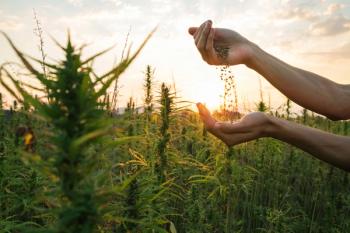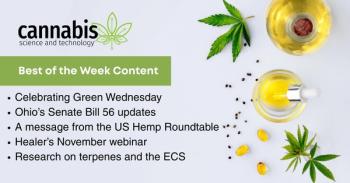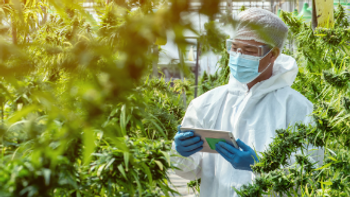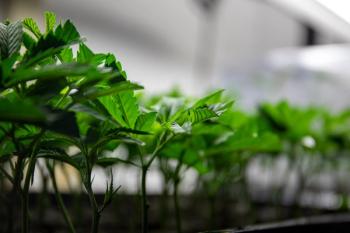
Cannabis Science and Technology
- March 2021
- Volume 4
- Issue 2
How LED Light Recipes and Controls Can Improve Quality and Yield for Cannabis Producers

Learn the ways light energy from different parts of the action spectrum can affect plant expression, harvest structure, and quality characteristics and how light-emitting diode light fixtures can be controlled to modulate light intensity and spectral distribution to produce different effects.
Learn the ways light energy from different parts of the action spectrum can affect plant expression, harvest structure, and quality characteristics and how light-emitting diode (LED) light fixtures can be controlled to modulate light intensity and spectral distribution to produce different effects.
Light is the primary nutrient used for photosynthesis and gives plants the energy needed for growth and development; the amount of photons from various wavelengths received by plant canopy influences yield and secondary metabolite expression. Cannabis has historically been grown with one kind of spectral distribution commonly provided by high intensity discharge (HID) lighting solutions such as high pressure sodium (HPS) or metal halide (MH). LED horticultural lighting offers broad spectral distribution, meaning any amount of photons of diverse wavelengths can be produced by one light fixture. LED lighting products also provide customizable spectral recipes and greater controllability than HID lighting products. Understand how LED light fixtures and spectral “recipes” stimulate plant responses like photosynthetic action and secondary metabolite production, areas of study, and the latest research.
The Influence of Light on Plants
The major factors influencing a plant’s growth and development are genotype and the energy provided by light, along with environmental factors such as fertigation, and grow room environmental factors such as CO2, temperature, and humidity.
Electromagnetic radiation—light energy—is a stream of photons, with each photon containing a certain amount of energy. Ultraviolet light waves have more energy than visible light, which means they bump into more things and can cause more damage the shorter the wavelength (1). Within the visible spectrum, photosynthetically active radiation (PAR) describes the wavelengths that drive photosynthesis with wavelengths of 400–700 nm. Wavelengths outside of the PAR range (such as ultraviolet [UV] and far red) affect plant development and phenotype, the set of observable quality characteristics resulting from the interaction of its genotype with the environment.
Light Intensity Matters Most
Light intensity—the quantity of photons—is most important to plants; wavelength of the photons comes second behind intensity. Photosynthetic photon flux measures the total amount of PAR that is produced by a lighting system each second, and photosynthetic photon flux density (PPFD) describes the amount of photons in the PAR range (photosynthetically active photons) that actually hit a given surface each second.
In cultivator studies comparing cannabis grown with light-emitting diode (LED) and high pressure sodium (HPS) light fixtures in the flowering stage, plants respond similarly in yield if given the same PPFD. This is possible because, unlike humans, plants detect and react to changes in light intensity more finely than changes in spectral distribution. Light intensity can also be the solution to adverse morphological impacts of spectral treatments, when too much of some photons can be a bad thing.
LED light fixtures are capable of producing more light than high intensity discharge (HID) or fluorescent light fixtures, allowing plants grown with LED to receive higher PPFD levels, meaning cannabis can be grown in high-PPFD environments unattainable with other lighting technologies. Some LED fixtures may have higher PPF than the best performing double-ended HPS fixtures and can be mounted closer to flowering canopies than HPS lights to increase PPFD.
Many LED products are also dimmable, allowing for crucial modulation capability to limit output to match target PPFD without physically moving light fixtures, ramp up light levels while plants grow, and raise and lower intensity for smooth sunrise and sunset transition periods. A few LED manufacturers produce spectrally tunable lights that can modulate the amount of photons from different wavelengths.
Emerging Data Establishing LED Efficiency and Productivity
Cannabis PowerScore is Resource Innovation Institute's (RII) voluntary resource benchmarking platform that gathers confidential facility information about energy use, production output, and cultivation methods, and provides operators with a competitive performance ranking relative to the aggregate Ranked Data Set. The PowerScore Ranked Data Set is analyzed to inform governments, utilities, and industry leaders on how—and how much—energy and water is being used across various cultivation environments. In 2020, RII evaluated the energy use of 84 indoor cannabis cultivation facilities and found that facilities using LED lighting were more energy efficient and productive on average than facilities without LED lighting (2).
RII’s analysis found that indoor operations using LED lighting for flowering growth stages achieved 34% better electric energy efficiency (unit of electricity per square foot of flowering canopy) and 80% better productivity (grams per unit of electricity) than indoor facilities using double-ended (DE) HPS lighting for the flowering growth stage.
Understand Light Recipes for Plants
Light recipes are polychromatic spectra produced by an array of different LEDs on a light fixture, resulting in unique ratios of spectra such as red/blue ratio and red/far red. HPS has a polychromatic spectra that is fixed. Spectral quantum distribution plots illustrate the distribution of photon flux per photon wavelength over the photosynthetic and far-red range wavelengths for a given light fixture.
LEDs provide a wide range of customizable spectral quantum distributions. LED light fixture manufacturers can provide unique light recipes targeting specific plant responses, including far-red and UV spectra that HID options cannot offer. Broad spectrum LEDs provide light treatments delivering photons from a lot of or all of the wavelengths across the PAR range, allowing for a greater proportion of blue, red, and far red photons to influence plant growth and development in beneficial ways. The impacts of changes to ratios between blue/red and red/far red are crucial for growers to understand to maximize the benefits of LED solutions.
Action spectrum graphs show the rate of biological effectiveness plotted against wavelength of light, usually related to the absorption spectrum of many systems. Phototransduction pathways—how plants receive light and use it for multiple systems in the plant such as those that regulate vitamin C, photosynthesis, photomorphogenesis (the physical effect of light on plants; shape, appearance, color, aroma), and leaf expansion—are very dependent on how light is captured and used. An action spectrum is a way of looking at a constant photosynthetic response rate based on individual wavelengths making up that constant response. Looking at constant response over a wavelength interval, results can show them to be additive (when adding up multiple wavelengths together, 1+1 = 2), sub-additive (1+1 = 1.5) or super-additive, like with the Emerson effect (1+1 = 4).
Manufacturers of LED lighting solutions run tests on their light fixtures and their array of diodes producing many wavelengths at once, which does not allow for growers to yet understand how each individual wavelength of light affects plant growth and development. Manufacturers can only describe polychromatic light, and until spectral distributions are broken into constituent parts by wavelength, we still do not yet know which parts of a spectrum are additive, sub-additive, or super-additive.
Light Quality Impacts Plant Qualities
Literature review of studies by and interviews with researchers at the National Aeronautics and Space Administration (NASA) Plant Biology and Bioregenerative Life Support, the US Department of Energy’s Solid State Lighting R&D Program, the Lighting Research Center at Rensselaer Polytechnic Institute, the Crop Physiology Laboratory at Utah State University, and the Sustainable Crop Production program of the Department of Horticulture at Michigan State University have established some key findings that RII can share with cannabis growers to use to create the optimal spectral treatments for their plants (4–8).
Cannabis secondary metabolites are complex; they can be broken into two basic families of compounds:
- cannabinoids, of which tetrahydrocannabinol (THC) and cannabidiol (CBD) are just two of more than 100; and
- terpenes, a large family of compounds associated with aroma and taste.
Geranyl pyrophosphate (GPP) is a building block in the biosynthesis of cannabinoids and monoterpenes; studies by lighting manufacturers have shown that GPP can be manipulated with light treatments, and they are actively researching the relationship between secondary metabolite expression and light spectra. Some growers working with them have found that light quality can influence these branching elements that affect THC and CBD content as well as terpene expression. Some academics disagree and feel that the effects of spectral quality on cannabinoids is small, finding no effect of spectral quality on CBD or THC concentration when comparing light treatments by changing light recipes.
Ranging from low to high wavelengths, different quantities of photons in the different portions of the light spectrum affect other aspects of plant expression in both good and bad ways. Years of study by researchers and in cultivator facilities across the world have established some key findings that cannabis growers can use to create the optimal light treatment for their plants.
Ultraviolet: UVC, UVB, and UVA
High-energy UV (100–400 nm) photons induce stress responses in the plant, and can suppress or inoculate plants against pathogens such as powdery mildew. Pigments are both aesthetic and chemical; UV can increase purpling of leaves and flowers, which is induced by greater presence of anthocyanin pigment.
There is a popular perception that UV can increase cannabinoid content like THC, but manufacturers working with cannabis cultivators have not proven that strategy to be substantially effective.
Blue
Blue (450–485 nm) is the wavelength with the greatest effect on plant quality factors such as secondary metabolite expression. Blue light also can influence pigmentation and chemical content of shoots, leaves, and flowers including terpene production. Research is continuing to determine which terpenes are most influenced by blue light.
More blue photons can result in enhanced expression of plant quality factors, but at the expense of lower yields. Blue wavelengths are suppressive of stretch and can counter elongation effects of other light spectra, producing bushier plants, shorter stems, and smaller leaves. A more compact plant can be good, but broader plants can get more airflow through the canopy. Blue stretch suppression can be mitigated in young plants by lowering light levels to limit PPFD and considering blue to red ratio. Blue to red ratio impacts plant yield and photomorphogenesis.
Red and Far Red
Red (625–700 nm) LEDs were developed the earliest and are the most efficient at converting energy into photosynthetic photons than blue diodes; far red (700-800 nm) LEDs perform even better. An LED light fixture with a lower blue to red ratio may be more energy efficient than one with a higher proportion of white diodes (which are used to produce blue wavelengths).
Red can be seen as the counterpoint to blue light; greater proportion of red photons can improve yields but adversely impact quality by influencing photomorphogenesis. Red and far red can also influence phytochrome metabolic pathways that fuel terpene production
Red drives photosynthesis and impacts plant yield; wavelengths 680 nm and higher increase the rate of photosynthesis via the Emerson Effect. As wavelengths approach 700 nm, plants respond to create larger leaves, which results in higher yields because bigger leaves are bigger collectors of photons; more photons collected can be used to generate more biomass. Far red wavelength doses during the day can induce leaf expansion, but can also stretch and elongate plants, which is not usually a desirable quality characteristic for cannabis. Increase light intensity (PPFD) to provide plants with more energy to limit elongation and keep plants short while using far red spectral treatments.
Infrared
Although heat energy and light are different, thermal energy produces radiation via infrared light waves (800–1000 nm), which are outside of the visible portion of the light spectrum. Every light fixture emits infrared light to some extent, but the warmer the light, the more infrared it emits. High-intensity discharge, high pressure sodium, and metal halide light fixtures run hotter, and LED light fixtures generally run cooler.
However, if LEDs are used in a high-PPFD scenario, heat output of the light fixture may increase. Some growers use fixtures with onboard cooling fans, or choose liquid-cooled lighting solutions to maximize PPFD while minimizing heat from lighting in grow rooms. Check manufacturer specification sheets for heat output in Btu per hour. The DesignLights Consortium’s Horticultural quality products list (QPL) also shows maximum ambient temperature of listed light fixtures along with SQD plots (which illustrate the distribution of photon flux per photon wavelength over various wavelengths and convey the specific light recipe of a light fixture) and other technical information (3).
Benefits of LED Lighting Solutions
LED can do anything HPS can do, better. LED products can offer light recipes and high-PPFD light intensities not attainable by HID lighting solutions and can incorporate unique capabilities such as continuous dimming and spectral tuning to produce various light intensities and recipes with one fixture. Consider tailoring LED light fixtures and controls to create light treatments for optimal plant growth and development. It is possible to achieve similar or better yields and quality characteristics with LED, and understanding how to modulate light intensity and spectral effects is key.
References
https://imagine.gsfc.nasa.gov/science/toolbox/emspectrum1.html .https://resourceinnovation.org/press-release/study-of-cannabis-energy-use-shows-indoor-cultivation-operations-using-led-lighting-demonstrate-better-efficiency/ .https://www.designlights.org/horticultural-lighting/search/ .https://www.nasa.gov/mission_pages/station/research/news/b4h-3rd/sv-plant-biolobgy-and-biogerneative-life-support .https://www.energy.gov/eere/ssl/about-lighting-rd-program .https://www.lrc.rpi.edu/ .https://caas.usu.edu/labs/cpl/research/ .https://www.canr.msu.edu/hrt/research/sustainable_crop_production_food_systems_and_agroecology .
About the Columnist
Gretchen Schimelpfenig, PE, is the Technical Director of RII and manages the organization’s Technical Advisory Council. She is an LED-lit home cultivator. While serving Burlington Electric Department customers, she incentivized horticultural LED lighting equipment through energy efficiency programs, and has commissioned LED lighting designs and installed systems in commercial and industrial buildings, including greenhouses used for academic research on hemp and other cultivars. She authored the RII Best Practices Guides on HVAC and LED Lighting for Cannabis Cultivation and Controlled Environment Agriculture. She has a B.S. in Architectural Engineering from the University of Wyoming and an M.S. in Civil Engineering from Stanford University. She is a licensed Civil Professional Engineer in California and Vermont.
How to Cite this Article
G. Schimelpfenig, Cannabis Science and Technology 4(2), 14-16, 23 (2021).
Articles in this issue
almost 5 years ago
Hemp Testing Insanity III: This Time It’s the USDA!almost 5 years ago
Quality Control Checkpoints in Cannabis Processingalmost 5 years ago
Why Does Leaf Temperature Matter in a Commercial Grow Room?almost 5 years ago
Around the World: Canada’s Footprint on the Cannabis Industryalmost 5 years ago
How to Distinguish Hemp from Marijuana with Mid-Infrared Spectroscopyabout 5 years ago
Quality Matters: A Chat with Keystone Labs President, Jodi McDonaldNewsletter
Unlock the latest breakthroughs in cannabis science—subscribe now to get expert insights, research, and industry updates delivered to your inbox.





